

Women in WW2. ; Fighters over the ages. ; Women aviators.
Throughout history, brave women distinguished themselves in battle against enemies, when necessary to defend their homes and their homeland. They have achieved high rank in the military and served in combat units alongside men.
Men were created stronger and larger than women and over the millenia were traditionally the hunters and fighters, women the home carers and child bearers. Men are more belligerent, have fought long campaigns to gain territory, expand empires or simply to capture booty and slaves. The women usually stayed at home to tend to their families, produce food and clothing. However when attacked by invaders, women have fought as valiantly as men to defend their homes and their homeland. If the battle was lost, their homes were destroyed, the women frequently raped and carried off as slaves.
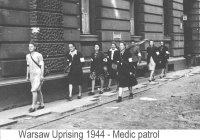 World War II brought the first large scale use of fighting women in the European countries occupied by the Nazis. The heroism of many of the female Underground workers in France. Norway and the Netherlands, and of female operators dropped in by parachute, such as Nancy Wake, Marie-Helene Lefaucheux, Corrie ten Boom, has been well documented in books and movies. Nevertheless, when the war was over, thse who survived were mostly forgotten, very few received a medal for their bravery. Most of them returned to the usual female role of mothers and home-makers.
World War II brought the first large scale use of fighting women in the European countries occupied by the Nazis. The heroism of many of the female Underground workers in France. Norway and the Netherlands, and of female operators dropped in by parachute, such as Nancy Wake, Marie-Helene Lefaucheux, Corrie ten Boom, has been well documented in books and movies. Nevertheless, when the war was over, thse who survived were mostly forgotten, very few received a medal for their bravery. Most of them returned to the usual female role of mothers and home-makers.
Jan Karski, the courier from the Polish Underground government to England, then the USA, wrote in his biography, published in Washington in 1944:
>>During the course of my work in liaison I came to sympathize deeply with the hard-working und suffering liaison women, the chief function of whom was to facilitate contacts between Underground workers. They were a vital link in our operations and were in many ways more exposed than those they helped bring together...
The average "life" of a liaison woman did not exceed a few months....(when) caught by the Gestapo... treated with bestial cruelty.... It can be said that of all workers in the Underground, their lot was the most severe, their sacrifices the greatest, and their contribution the least rewarded.>>
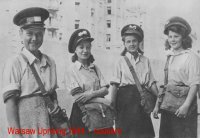 Among the many female heros of the Polish Underground: the courier Elżbieta Zawacka who carried documents criss-crossing occupied Europe, Maria Wittek (who became the first woman general in the Polish Army), and Irena Sendler stand out. Irena Sendler, together with a number of other young women and nuns, smuggled about 2,500 Jewish children out of the ghetto and saved them. Caught by the Gestapo in October 1943, she was tortured and sentenced to death. But she was rescued and survived the war, still continuing her work, to be awarded highest awards by Israel and post-communism Poland.
Among the many female heros of the Polish Underground: the courier Elżbieta Zawacka who carried documents criss-crossing occupied Europe, Maria Wittek (who became the first woman general in the Polish Army), and Irena Sendler stand out. Irena Sendler, together with a number of other young women and nuns, smuggled about 2,500 Jewish children out of the ghetto and saved them. Caught by the Gestapo in October 1943, she was tortured and sentenced to death. But she was rescued and survived the war, still continuing her work, to be awarded highest awards by Israel and post-communism Poland.
During the 63 day long Warsaw Uprising in 1944, women played a prominent part, mainly as couriers and medics, but also in staff positions and on the front-line during attacks. When the Nazis finally granted the fighting Poles full combatant rights in accordance with International Law and the fighters capitulated, the German Army was obliged to set up two separate P.O.W. camps to accommodate the 20,000 women prisoners, many teen-agers.
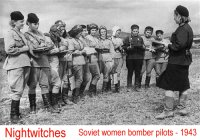 Fighting women played an important role in the Soviet army, especially in the defense of Stalingrad and operating anti-aircraft artillery.A A unit knicknamed the night-witches flew old bombers, discarded by male pilots, and completed close to 200 night bombing missions behind the German front lines.
Fighting women played an important role in the Soviet army, especially in the defense of Stalingrad and operating anti-aircraft artillery.A A unit knicknamed the night-witches flew old bombers, discarded by male pilots, and completed close to 200 night bombing missions behind the German front lines.
In the British army, many women lost their lives serving in anti-aircraft artillery and the Auxiliary Air Force as pilots ferrying new aircraft across the Atlantic.
In the United States, several hundred thousand women served in the various branches of Armed Forces, but few were closely involved in actual action, except in the Phillipines and on convoys.
The Greek writer Herodotus (5th century B.C.E.) wrote about a tribe of women warriors, which he called Amazons, supposedly reigning somewhere around the Black Sea. Recent archaeological diggings in southern Russia, north of the Black Sea, have uncovered graves of armed Sarmatian women usually including bows.
 During history there have been many accounts of women fighting independently. or alongside their husband, and also leading troops into battle, even in Asia and Africa.
During history there have been many accounts of women fighting independently. or alongside their husband, and also leading troops into battle, even in Asia and Africa.
Prominent examples:
In ancient China, Fu Hao commanded an army of 12,000, about 1200BCE, in the Shang dynasty
and
Liu Jinding, at age 17. lead an army to defend the early Song dynasty (980CE) against an invasion from the south.
Well known examples of warrior women are the Celtic queen Boudica in Britain leading her troops in battle against the Romans. Even better known is the story of Jeanne d'Arc, the Maid of Orleans, rallying the French knights to battle against the British invaders of France in the 15th century.
In later history, Lady Ann Cunningham of Scotland raised a cavalry troop and led them on horseback in the Battle of Berwick against England in 1639. The result of this battle led to the Scots gaining right to a free church assembly and a free parliament.
 In 1831, the Polish Countess Emilia Plater created her own unit of volunteers to fight in the November insurrection against the occupying Russians. She later commanded an infantry unit and was promoted to Captain.
In 1831, the Polish Countess Emilia Plater created her own unit of volunteers to fight in the November insurrection against the occupying Russians. She later commanded an infantry unit and was promoted to Captain.
In America,
Harriet Tubman, a Virginia slave escaped to Pennsylvania. She created the "underground railroad" to help 100s of slaves to excape to freedom in northern states and Canada. In the Civil War she worked as an armed spy for the Union forces and lead the Combahee River Raid which freed 2,000 slaves.
At the Battle of Little Big Horn. 1878, several women were among the Siuox warriors that defeated Gen. Custer.
Denied the possibility to fight in wars for freedom, many women served dressed as men. These include Deborah Sampson who, in 1782, enrolled in the Fourth Massachusetts Regiment to fight in the American Revolution.When wounded in the leg, she tended her own wounds to avoid detection. Later in life she 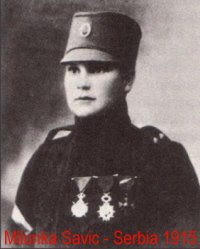 was awarded a military pension (however much less than male veterans received).
was awarded a military pension (however much less than male veterans received).
In Russia, Nadezhda Durova, dressed as a man, served in the army from 1806 to 1816 and fought against the invading French in 1810-1812, achieving the rank of Captain. Later, wounded and revealed as a woman, she personally received a high award, the St.George Cross, from the Tsar.
In World War I, many nations enrolled women into auxiliary army or navy units as nurses, ambulance drivers, clerical assistants to staffs, but not in combat roles. A number of women were used as spies, including the famous Mata Hari, who was caught and executed.
In the Serbian army, Milunka Savić had fought in the Balkan Wars (1912 and 1913) disguised as a man. Her identity was revealed when she became wounded, but she was allowed to stay in the army. In World War I she served as a subaltern, was wounded several times. She was the only female, of any nationality, to receive the French Croix de Guerre with Palms for her service, in addition to high Serbian and Russian awards.
Flying is not the same as fighting, but, at least in the early years, involved considerable risks.
In 1912 the first known case of a woman flying on a military mission occurred in Bulgaria, Rayna Kasabova flew on a mission over Turkish front lines, at the age of 15. Later she obtained a pilot's license and flew missions in the Second Balkan War. The Kasabova Glacier in Antartica is named for her.
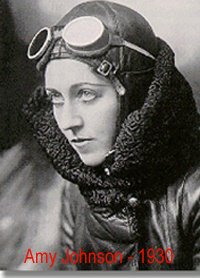 Amy Johnson, 1903-1941, was one of the first women to gain a pilot's licence. Johnson won fame when she flew solo from Britain to Australia in 1930. Her dangerous flight in a tiny single engine Gypsy Moth plane, took 17 days. Later she flew solo to India and Japan and became the first woman to fly across the Atlantic East to West (against the prevailing wind, however not solo). In WW2 she volunteered to fly for The Women's Auxiialry Air Force and was shot down over the River Thames and killed, in 1941.
Amy Johnson, 1903-1941, was one of the first women to gain a pilot's licence. Johnson won fame when she flew solo from Britain to Australia in 1930. Her dangerous flight in a tiny single engine Gypsy Moth plane, took 17 days. Later she flew solo to India and Japan and became the first woman to fly across the Atlantic East to West (against the prevailing wind, however not solo). In WW2 she volunteered to fly for The Women's Auxiialry Air Force and was shot down over the River Thames and killed, in 1941.
Harriet Quimby was the first American woman licensed to fly, in 1912. A year later she was the first woman to fly across the English Channel, but was killed in an accident a year later.
Amelia Earhart was the first woman to cross the Atlantic solo - she had previously crossed the Atlantic in 1926 as a member of a crew. She became world famous when she disappeared over the Pacific in 1936 during an attempted round-the-world flight.
The English woman, Beryl Markham became the first female commercial pilot and ferried passengers and mail in Kenya and Central Africa in the early 1930s. In 1936 she became the first woman to fly solo across the Atlantic west to east (against the prevailing winds). In the film "Out of Africa" she is depicted as Felicity.
Sabiha Gõkçen, one of the adopted daughters of the Turkish president Kamal Ataturk, was the first Turkish woman pilot in 1935 and flew military missions, dropping bombs on insurgents in 1937.
NOTE: Many Women have been named above. They have been selected to be representative of the many thousands, of brave women fighters and aviators, over many centuries.
Continue to the story of influential women scientists and political leaders at influential_women.shtml
Return to top of page
Return to Home page
Go to history index for many articles about history and national customs.
Illustrations are courtesy of Wikipedia.org under Creative Commons Attribution-Share Alike 3.0 Unported license.
Other history essays
Timeline of
Fighting women
over the centuries.
Timeline of Women aviators
Accounts of participants in
Warsaw Uprising 1944, including several by women.
